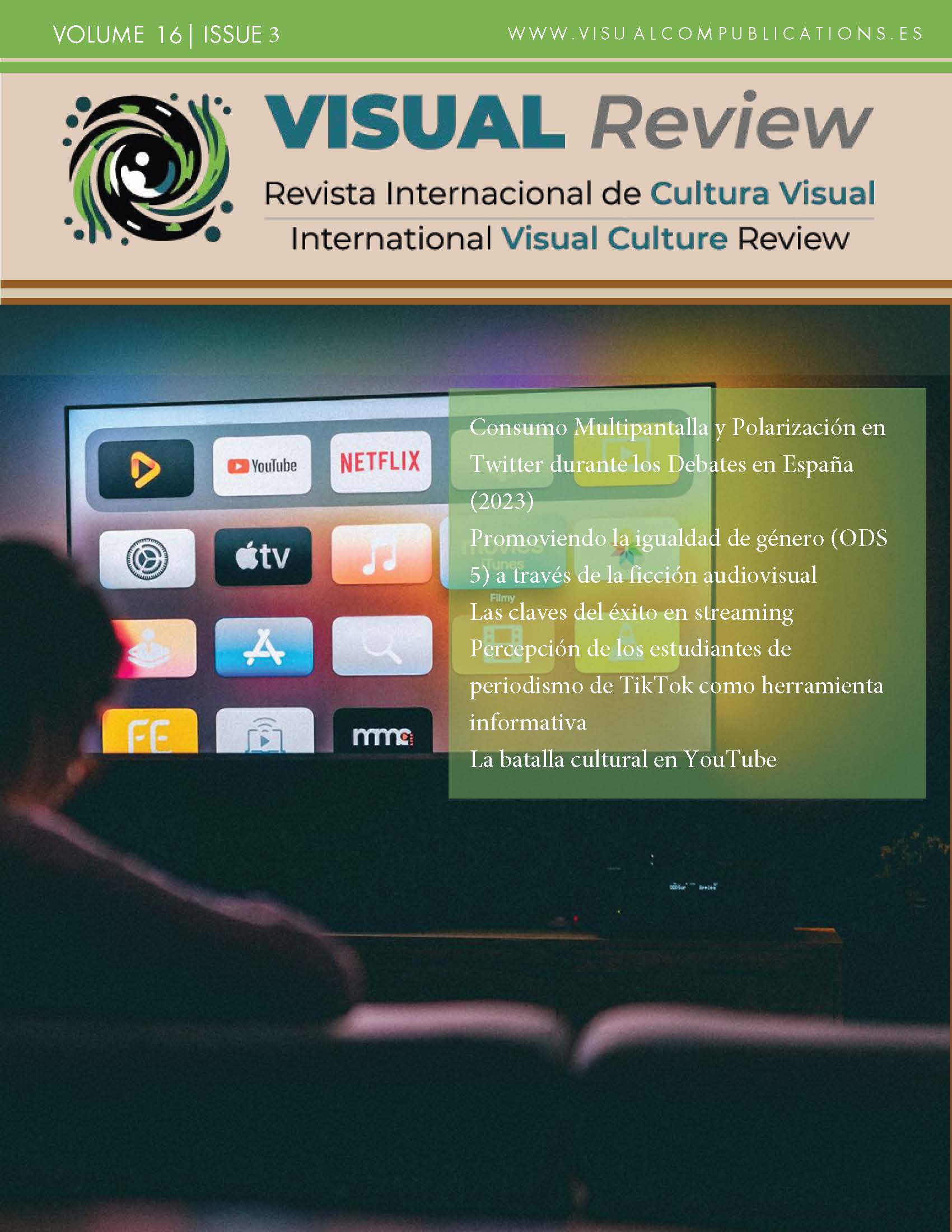Content distribution to segmented audiences: platforms and the crowd concept.
Study case: Infinito+1
DOI:
https://doi.org/10.62161/revvisual.v16.5191Keywords:
audiences, crowdfunding, religious, community, platform on demand, documentary, filmsAbstract
This article aims to analyze how the new distribution windows interrupt the distribution of audiovisual content. For this, the case of the production company Infinito+1 is studied when approaching a specific segment of the audience: the religious community. The behavior of this type of so-called niche audience offers a diversity of possibilities within content distribution, such as crowdfunding, crowdsourcing or platform on demand. These actions will be analyzed and studied with the idea of understanding the actuality of the audiences and the distribution of content.
Downloads
Global Statistics ℹ️
|
506
Views
|
371
Downloads
|
|
877
Total
|
|
References
Abad, M.J., de la Cierva, Y. Rubio, R. (2013). Así fue las JMJ y así la contamos: Case study de comunicación de un evento global. Pamplona: EUNSA, 2013. Print. Biblioteca Dircom.
ADICINE (2021). Rueda de prensa ADICINE. https://bit.ly/45aCJ48 emitido el 3 de febrero de 2021.
Álvarez Monzoncillo, J., (2011). La televisión etiquetada: Nuevas audiencias, nuevos negocios / coordinador: José María Álvarez Monzoncillo; colaboradores: Juan Pablo Artero... [et al.] (1ª ed., Fundación Telefónica). Madrid: Fundación Telefónica; Barcelona: Ariel.
Baber, H., Fanea-Ivanovici, M. (2021). What drives people to crowdfund movies and web series? The mediating role of perceived trust and risk. Economic Computation and Economic Cybernetics Studies and Research, 55(3), 279-296. DOI: https://doi.org/10.24818/18423264/55.3.21.18
Botto, R. (2017). Crowdsourcing for Filmmakers. En Routledge eBooks. https://doi.org/10.4324/9781315725130 DOI: https://doi.org/10.4324/9781315725130
Buquet Corleto G. (2005). El poder de Hollywood: un análisis económico del mercado audiovisual en Europa y Estados Unidos. Fundación Autor.
Castillo, J. I., & Latorre-Lázaro, T. (2022). Oferta de contenidos de las plataformas audiovisuales. Hacia una necesaria conceptualización de la programación streaming. Profesional De La Informacion. https://doi.org/10.3145/epi.2022.mar.18 DOI: https://doi.org/10.3145/epi.2022.mar.18
Comscore (2015). Informe anual de Cine 2014.
Comscore (2016). Informe anual de Cine 2015.
Comscore (2017). Informe anual de Cine 2016.
Comscore (2018). Informe anual de Cine 2017.
Comscore (2019). Informe anual de Cine 2018.
Comscore (2020). Informe anual de Cine 2019.
Comscore (2021). Informe anual de Cine 2020.
Cotelo, J.M. (2010). La última cima. Infinito+1.
Cotelo, J.M. (2013). Tierra de María. Infinito+1.
Cotelo, J.M. (2016). Footprints. Infinito+1.
Cotelo, J.M. (2018). El mayo regalo. Infinito+1.
Cotelo, J.M. (2021). Tengamos la fiesta en paz. Infinito+1.
Elberse, A. (2014). Superventas. Gestión 2000.
El Blog de Cine Español. (2011, mayo 24). “La última Cima” recibe El premio Al mejor documental en El festival internacional de cine católico de Mirabile de Roma. https://bit.ly/3Mapat2
El Blog de Cine Español. (2010, junio 30). Entrevista a Juan Manuel Cotelo, director Del documental “la última Cima”. https://bit.ly/3Mz5mRi
Gibson, M. (2004). La pasión de Cristo. IconProductions
Goldman, W. (1983). Adventures in the screen trade: a personal view of Hollywood and screenwriting. Warner Books.
Gruvi (2017): Winning your Audiences. Marketing Movies in the Connected World. Ebook. https://www.gruvi.tv/ebook/
Gutiérrez-Rubí, Antoni; Freire, Juan (2013). Manifiesto Crowd. La empresa y la inteligencia de las multitudes. Laboratorio de Tendencias. http://www.manifiestocrowd.com
Hennig‐Thurau, T., Ravid, S. A., & Sorenson, O. (2021). The economics of filmed entertainment in the digital era. Journal of Cultural Economics, 45(2), 157–170. https://doi.org/10.1007/s10824-021-09407-6 DOI: https://doi.org/10.1007/s10824-021-09407-6
Howard, R. (2006). El código da Vinci. Sony
ICAA (2011). Boletín informativo 2010. Películas, recaudaciones, espectadores. http://bit.ly/3OBz3CN
ICAA (2012). Boletín informativo 2011. Películas, recaudaciones, espectadores. http://bit.ly/3OBz3CN
ICAA (2013). Boletín informativo 2012. Películas, recaudaciones, espectadores. http://bit.ly/3OBz3CN
ICAA (2014). Boletín informativo 2013. Películas, recaudaciones, espectadores. http://bit.ly/3OBz3CN
ICAA (2015). Boletín informativo 2014. Películas, recaudaciones, espectadores. http://bit.ly/3OBz3CN
ICAA (2016). Boletín informativo 2015. Películas, recaudaciones, espectadores. http://bit.ly/3OBz3CN
ICAA (2017). Boletín informativo 2016. Películas, recaudaciones, espectadores. http://bit.ly/3OBz3CN
ICAA (2018). Boletín informativo 2017. Películas, recaudaciones, espectadores. http://bit.ly/3OBz3CN
ICAA (2019). Boletín informativo 2018. Películas, recaudaciones, espectadores. http://bit.ly/3OBz3CN
ICAA (2020). Boletín informativo 2019. Películas, recaudaciones, espectadores. http://bit.ly/3OBz3CN
ICAA (2021). Boletín informativo 2020. Películas, recaudaciones, espectadores. http://bit.ly/3OBz3CN
ICAA (2022). Boletín informativo 2021. Películas, recaudaciones, espectadores. http://bit.ly/3OBz3CN
Jenkins H. (2009). Fans blogueros y videojuegos: la cultura de la colaboración. Paidós Comunicación.
Jenkins H., Ford S. Green J. (2015). Cultura transmedia: la creación de contenido y valor en una cultura en red (1ª). Gedisa.
Kalijonen, Johanna (2016). Nostradamus Screen Visions 2016. Göteborg Film Festival. nostradamusproject.org
Kirsner S. (2009). Fans friends & followers (1st ed.). Scott Kirsner.
Linares Palomar, Rafael & Baraybar, Antonio. (2017). The empowerment of the film spectator: Theatrical on demand in Spain. El Profesional de la Información. 26. 67. https://doi.org/10.3145/epi.2017.ene.07. DOI: https://doi.org/10.3145/epi.2017.ene.07
Ministerio de Cultura. Encuesta de Hábitos y Prácticas Culturales en España 2010-11. http://bit.ly/3qbogoC
Monzoncillo, J. M. Á., & Villanueva, J. L. (2015). Vidas paralelas de las películas: circuitos estratificados de distribución y consumo. adComunica. Revista Científica de Estrategias, Tendencias E Innovación En Comunicación, 21-40. https://doi.org/10.6035/2174-0992.2015.10.3 DOI: https://doi.org/10.6035/2174-0992.2015.10.3
Mora, Juan Manuel. La Iglesia, el Opus Dei y el Código da Vinci: un caso de comunicación global. 1ª edición: EUNSA, 2009. Print. Bublioteca Dircom
Neira, E. (2020) Streaming wars. La nueva televisión. Libros cúpula.
Neira, E., Clares-Gavilán, J., Sánchez-Navarro, J. (2021). New audience dimensions in streaming platforms: the second life of Money heist on Netflix as a case study. Profesional de la información, 30(1). https://doi.org/10.3145/epi.2021.ene.13 DOI: https://doi.org/10.3145/epi.2021.ene.13
Pakula, O. (2021). The Streaming Wars: An Analysis of Anticompetitive Business Practices in Streaming Business. UCLA Entertainment Law Review, 28(1), 147. https://doi.org/10.5070/LR828153859 DOI: https://doi.org/10.5070/LR828153859
Palacios, F. (1962). La gran familia. Pedro Masó P.C.
Pardo, A. (2007). The Europe-Hollywood Coopetition: Cooperation and Competition in the Global Film Industry, Media Markets Monographs, Servicio de publicaciones de la Universidad de Navarra, Pamplona.
Peli, O. (2007). Paranormal activity. Blumhouse productions.
Roig, A., Sánchez-Navarro, J., & Leivobitz, T. (2017). Multitudes creativas. El crowdsourcing como modelo para la producción audiovisual colectiva en el ámbito cinematográfico. Profesional de la Información, 26(2), 238. https://doi.org/10.3145/epi.2017.mar.10 DOI: https://doi.org/10.3145/epi.2017.mar.10
Santo, I. (2020). El palmar de troya. Movistar.
Sorrentino, P. (2016). El joven papa. Haut et Court TV
Yin, Robert K. (2009). Case Study Research. Design and Methods, 4ª ed. Sage, Thousand Oaks.
Downloads
Published
How to Cite
Issue
Section
License
Copyright (c) 2024 VISUAL REVIEW. International Visual Culture Review / Revista Internacional de Cultura Visual

This work is licensed under a Creative Commons Attribution-NoDerivatives 4.0 International License.
Those authors who publish in this journal accept the following terms:
-
Authors retain copyright.
-
Authors transfer to the journal the right of first publication. The journal also owns the publishing rights.
-
All published contents are governed by an Attribution-NoDerivatives 4.0 International License.
Access the informative version and legal text of the license. By virtue of this, third parties are allowed to use what is published as long as they mention the authorship of the work and the first publication in this journal. If you transform the material, you may not distribute the modified work. -
Authors may make other independent and additional contractual arrangements for non-exclusive distribution of the version of the article published in this journal (e.g., inclusion in an institutional repository or publication in a book) as long as they clearly indicate that the work was first published in this journal.
- Authors are allowed and recommended to publish their work on the Internet (for example on institutional and personal websites), following the publication of, and referencing the journal, as this could lead to constructive exchanges and a more extensive and quick circulation of published works (see The Effect of Open Access).













